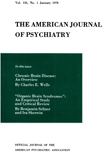Feminine Behavior in Boys: Aspects of Its Outcome
Abstract
The author studied the outcome of 16 subjects who had exhibited feminine behavior as young boys. A structured interview, devised b culling from the literature those factors considered to be associated with gender identity disturbances, and a battery of psychological tests were administered. Six of the subjects showed markedly deviant gender identities; three were transsexuals, one a transvestite, and two homosexuals. There appeared to be two peaks for the age of onset of symptoms: before age six and after age ten. The data suggest that those with the earlier age of onset are more likely to develop severe gender identity disturbances.
Access content
To read the fulltext, please use one of the options below to sign in or purchase access.- Personal login
- Institutional Login
- Sign in via OpenAthens
- Register for access
-
Please login/register if you wish to pair your device and check access availability.
Not a subscriber?
PsychiatryOnline subscription options offer access to the DSM-5 library, books, journals, CME, and patient resources. This all-in-one virtual library provides psychiatrists and mental health professionals with key resources for diagnosis, treatment, research, and professional development.
Need more help? PsychiatryOnline Customer Service may be reached by emailing [email protected] or by calling 800-368-5777 (in the U.S.) or 703-907-7322 (outside the U.S.).



